Several years ago, I presented a painting of an SP&S E-7 locomotive prepared by General Motors design staff. I noted that the locomotive wasn’t actually delivered in those colors; instead, it was painted in the Great Northern Empire Builder colors. I’ve since learned that I was wrong; it didn’t receive the Empire Builder paint job until 1951.

Click image to download a 5.0-MB PDF of this paint diagram. Click here to download a 2.5-MB JPG of this paint diagram.
The above paint diagram, which is dated May 18, 1948, is from General Motors files and I am grateful to Joe Molinari for contributing a copy to Streamliner Memories. While this doesn’t absolutely prove that the locomotive was painted in those colors when it was delivered to the SP&S in 1948, photographic evidence below shows that it was.
Oren Hall was an engineer on the SP&S and took many photos of locomotives. He also kept good notes about his experiences on the railroad. His grandson, Michael Hall, turned those notes and photos into a slide show at the SP&S Historical Society convention in 2022. He generously gave me permission to present some of those photos, his grandfather’s notes, and his own comments here. A few comments of my own are designated by brackets. Click on any of the images for a larger view.
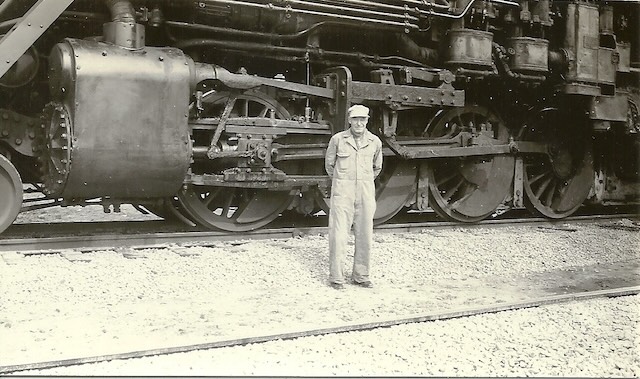
Engineer Oren L. Hall, Sr. — Engine No. 509 in Background — June 1944
Engineer Hall started work for the Oregon Electric Railway on September 02, 1910. That was the year that James Hill purchased the OE. He was quickly pulled over to the SP&S where he became a Hostler Helper. He was promoted to Fireman May 10, 1912 and to Engineer on July 6, 1927.
He retired in 1961 having taken 18 months out to serve in World War I. During the war he was a fireman in the 315 Railway Engineers of the American Expeditionary Forces in France. SP&S awarded him a 50 year service pin, acknowledging his time and seniority without a gap for WWI service.
The following comments on each photograph are from Oren Hall’s own notes.
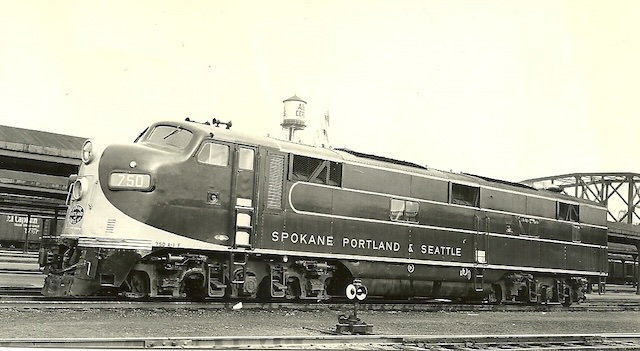
Engine No. 750: GM EMD – 2000 hp.
First diesel purchased, but delivery delays caused it to arrive after 800/801. No. 750 was received in July 1948, this photo taken in 1949. This was the “Flagship” of the new SP&S “Streamliners.”
After WWII there was a tremendous push in the railroad industry to modernize the fleets. No. 750 was used exclusively on passenger runs between Portland and Spokane, where it was most visible to the public. The senior engineers were given the choice to move up to diesels. I elected to stay with the 910 and 911. Never ran this one, I was freight.
In 1951 GN inaugurated a program to renew passenger loyalty and take the business back from the airlines that were stealing passengers in great numbers. GN spent huge sums of money calling it the new Mid-Century Empire Builder. The company repainted 750 to the GN Empire Builder colors.
This angered many of the SP&S loyal employees, and we voiced our opinion. We are the Portland to Spokane choice for most people. We are the ones that kept UP at bay and on the other side of the river. The company painted our colors back a year later.
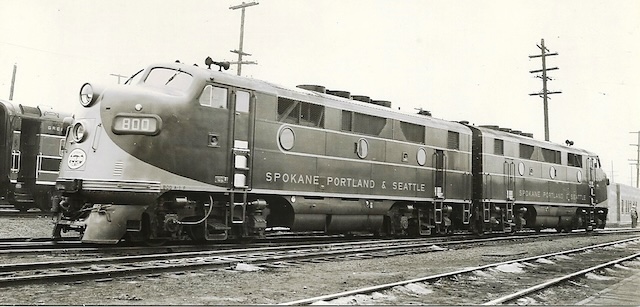
Both of these were GM-EMD, Model F-3A, 1500 horsepower.
Engines #800 and #801 were received in 1947 as a coupled pair. As delivered, this was 800-A-1 and 800-A-2. In 1948 they were split and began operating as singles. I was told the controllers were difficult and smooth starting was a problem when coupled. Engine 800-A-2 then became engine #801.
The controls were independent after the split, but I never knew how the controls were changed. The cab sheet metal was horrible on both 750 and 800. Initially these were rejected by inspectors at the factory. But the company wanted them, the 750 was already late, so they accepted them.
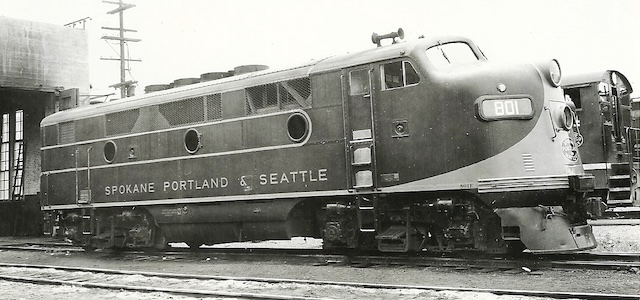
Engine #801 after the split. Notice they did better with the cab sheet metal on this one.
I started my diesel training on 801. It was a new world to me. No more watching water levels, steam pressure, and doing blowdowns. In fact, my fireman and I talked more, just to stay awake some nights.
We did like being fully enclosed, no choking on the exhaust, a lot less noise. I began classroom training on March 19, 1956. First time at the throttle (which we were instructed to say “controls”) was two weeks later on April 2nd. Then I had a gap in training since I was still running 910 to Spokane. Last run on 910 was June 23rd, 1956.
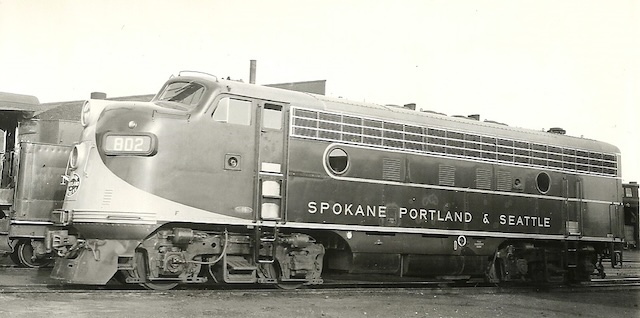
Engine #802 – Purchased in 1947, received in 1948 – GM /EMD, Model F-3A, 1500 horsepower.
After my last run on 910, I immediately resumed my diesel training on both the 801 and 802. I liked 802 better it ran smoother and the controller responded better. Brake blending was better. Other engineers agreed. I spent 1956 thru most of 1958 running 802 between Portland and Pasco.
No. 802 arrived the same week as 750. It was a one off purchase. No’s 800, 801, and 802 ran mostly freight, some mix, to Pasco. The trains were shorter than my 910 runs. I viewed it as a step down to the short Pasco trains. But since I was the second to the last steam engineer, my pay rate was grandfathered in, in the 1956 Contract.
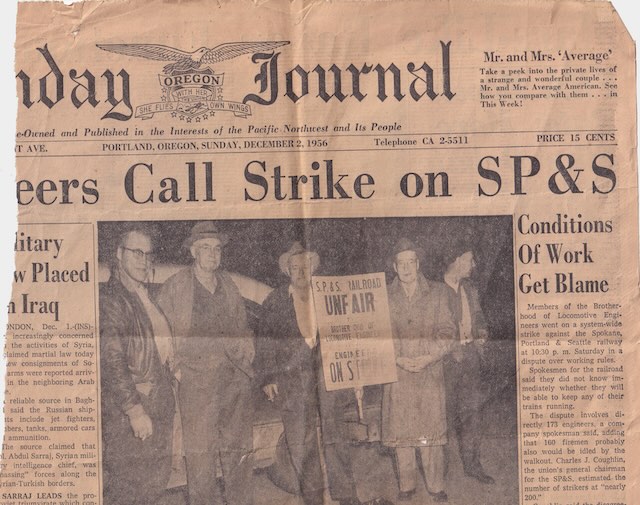
SP&S engineers called a strike in 1956. Oren Hall joined the picket line and is shown here second from the right.
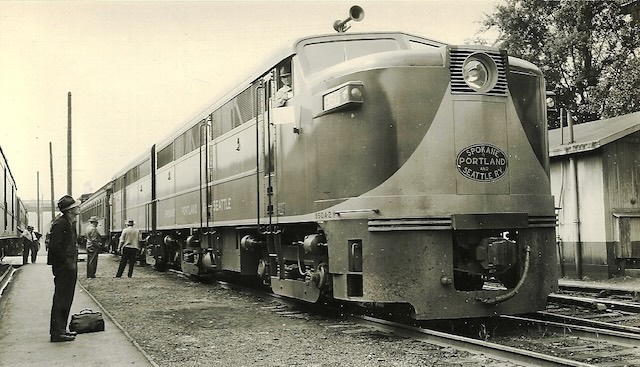
Married Pair – Right to Left: (Alco) 850 A2, 850 A-1 – After Split: 853 & 850.
Most steam engineers bragged that their machine was the best in the fleet. There was notable difference in the performance of each steamer, even between two with consecutive build dates. It might of just been our imagination thinking that, but I included, thought the 910 ran better than the 911; and my old 509 was the best of the 0-4’s (2-8-2).
With diesels, it was the same. I started with the EMD’s. I moved to these ALCO 850 and 853. It was after the split, but they tended to run these together. Only ran them about four trips, and was glad to get back to 802.
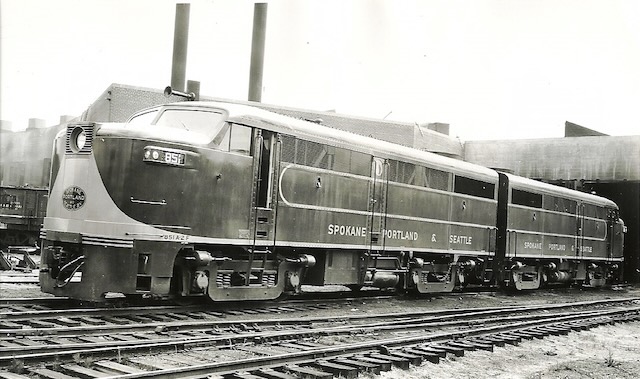
Married Pair — Right to left: 851 A2, 851 A-1; after split 851 & 854.
No. 850 A1/A2, 851 A1/A2 & 852 A1/A2 were all ALCO F-1’s, 1500 hp. They were split and renumbered 850 thru 855.
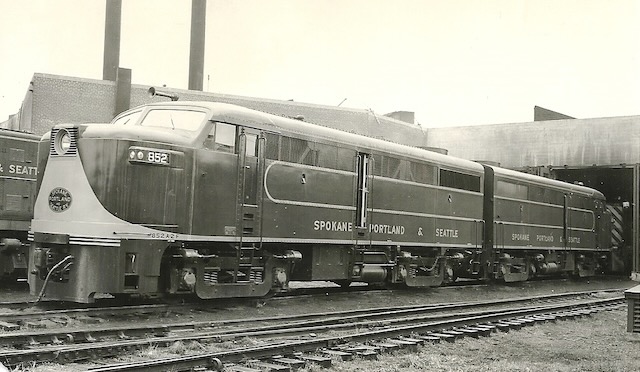
Married Pair — Right to left: 852 A2, 852 A-1; after split 852 & 855.
The driving reason for the split was not the controls. Although the ALCO controls were better as both singles and when coupled. However, the company needed more flexibility with their small fleet. They wanted to mix any engine in the fleet into any train.
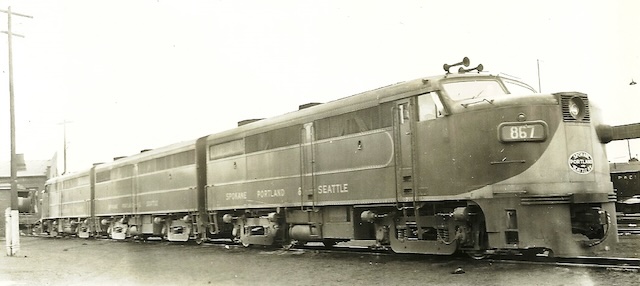
Individuals — Right to left: 867, 211, 859.
I ran this combination beginning in August 1958. These were Alcos, and I required a “readjustment” training. Made four ferry trips over to Vancouver with the trainer. Then first mainline to Spokane. Company insisted I have senior with me on first Spokane run. Had a tendency to overbrake until I got used to it.
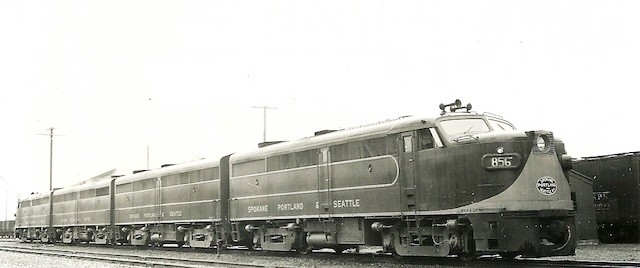
Married Quad – Right to Left: 856 A-2, 856 B-2, 856 B-1, 856 A-1.
Rode back from Spokane twice on this quad. I believe these stayed together as a coupled quad all their life. The Alco synchronous controls were better than GM.
You could feel tremendous power difference. These were new in 1948. Total HP was 6000!
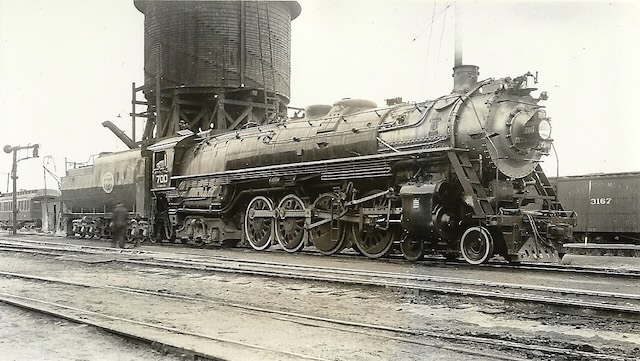
[Baldwin delivered the 700 to the SP&S in 1938. It was retired in 1956 after pulling the railway’s “Farewell to Steam” train.]
The End of an Era!
Dieselization of the SP&S fleet was completed in 1955. The only 4 Steamers left operating were the 539, 700, 910 & 911. Passenger runs were all diesel beginning September 1955.
On May 20th 1956, a “Farewell to Steam” run from Portland to Wishram was held to commemorate the last of the era of steam. The Conductor was Gabe Waldorf and his Engineer was Thomas Craine. SP&S No. 700 pulled 1400 passengers in a consist of 21 cars.
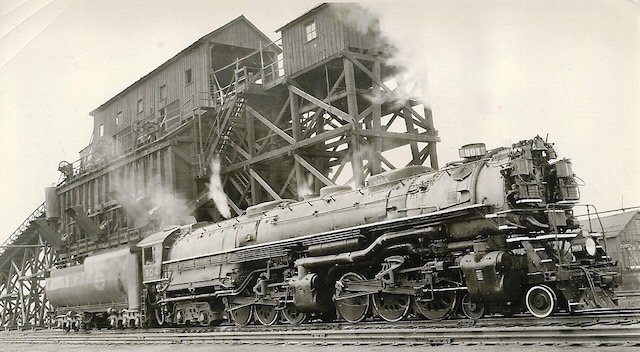
[ALCO delivered the 900-series 4-6-6-4 locomotives, represented here by the 904, to the SP&S in 1937. The six 900s, numbers 900 through 905, were nearly identical to NP’s Z-6 locomotives except that they burned oil instead of coal. In 1944, SP&S purchased two more 4-6-6-4s numbered 910 and 911.]
No. 539, 910, and 911 operated on freight runs into June of 1956. The actual last steam run was made by No. 910, on June 23 1956. No. 911 made its last run the week before with Engineer Hall at the throttle.
